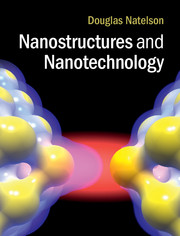Book contents
- Frontmatter
- Contents
- Preface
- Part I
- Part II
- 6 Charge transport and nanoelectronics
- 7 Magnetism and magnetoelectronics
- 8 Photonics
- 9 Micro- and nanomechanics
- 10 Micro- and nanofluidics
- 11 Bionanotechnology: a very brief overview
- 12 Nanotechnology and the future
- Appendix Common quantum mechanics and statistical mechanics results
- References
- Index
9 - Micro- and nanomechanics
from Part II
Published online by Cambridge University Press: 05 July 2015
- Frontmatter
- Contents
- Preface
- Part I
- Part II
- 6 Charge transport and nanoelectronics
- 7 Magnetism and magnetoelectronics
- 8 Photonics
- 9 Micro- and nanomechanics
- 10 Micro- and nanofluidics
- 11 Bionanotechnology: a very brief overview
- 12 Nanotechnology and the future
- Appendix Common quantum mechanics and statistical mechanics results
- References
- Index
Summary
From the earliest discussions of nanotechnology, there has been an interest in the development of mechanical devices with moving parts on the nanoscale. Biological systems demonstrate that this is possible, as cells routinely employ molecular machines with mechanical motions and degrees of freedom. Here we give an overview of the principles of the mechanics of solids, also known as continuum mechanics, with its concepts of stress, strain, and elastic moduli. As its name implies, continuum mechanics is based on the assumption of matter being continuous, rather than made up of discrete atomic units. In analogy with our previous treatment of electronic structure, it is interesting to explore the limits of this approach, which clearly must fail in the limit that chemistry becomes a more appropriate formalism. We also consider the origins of irreversibility in mechanical systems, including plastic deformation and friction, and see that nanoscale tools have been invaluable in increasing our understanding. After surveying Micro- and nanoelectromechanical systems (MEMS and NEMS) as they are employed in current technologies, we will conclude with a discussion of the frontiers of nanomechanics.
Basics of solid continuum mechanics
We need to define some basic terms so that we can discuss the elastic properties of solids, the relationship between the deformation of a piece of material and the forces acting on that object. Consider a block of material at rest being acted upon by several forces that sum vectorially to zero, so that the block is not accelerating. Now imagine dividing the block into two pieces. Clearly the sum of forces acting on each piece must equal zero, since neither piece is accelerating, as before. That implies that one piece of the material is exerting forces on the other piece, and vice versa. In this example, the material deforms due to the actions of the external forces, developing the necessary internal forces to maintain static equilibrium as a result of that deformation.
- Type
- Chapter
- Information
- Nanostructures and Nanotechnology , pp. 429 - 468Publisher: Cambridge University PressPrint publication year: 2015



